 |
Fortaleza de Hacho
Ceuta, Spain
|
|
 |
Constructed: 1770's
Used by: Spain
Conflicts in which it participated:
None
Also known as:
Fortaleza del Monte Hacho
|
In the historical period known as antiquity (loosely described as beginning in the 8th century BC and ending who knows when), imaginary divine hero Hercules pushed apart Spain and Africa, creating the Strait of Gibraltar.
A byproduct of this feat were the Pillars of Hercules, which are the Rock of Gibraltar on the northern side of the strait, and (possibly) Monte Hacho on the southern. Imaginary though he may well have been, we of the starfort persuasion owe Hercules a debt of gratitude for causing such a stellar fortification opportunity. |
 |
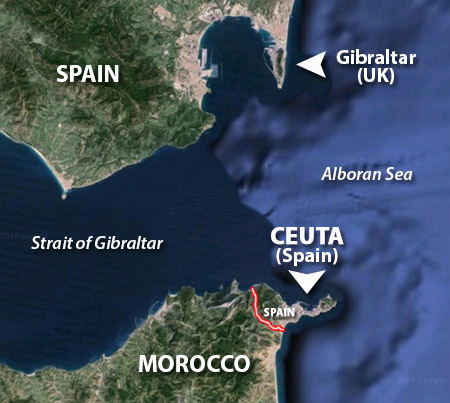 |
|
A desirable spit of land due to its commanding location on a major nautical trade route, what is today Ceuta has never lacked for suitors. The Carthaginians were the first to put down roots there, in the 5th century BC. The Romans built the first fortification on Monte Hache, Castellum ad Septem Fratres (Castle for Seven Brothers, thus named as seven mountains on Ceuta were known as "The Seven Brothers"), at or around the 1st century AD. Following collapse of the Roman Empire in the 5th century AD, the usual suspects of Vandals, Visigoths, Byzantines, Berbers and Moors paraded through Ceuta.
|
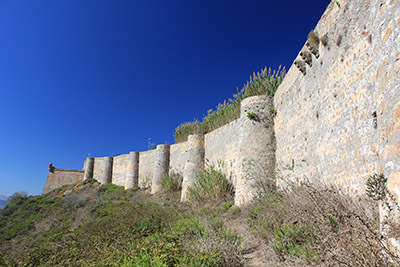 Fortaleza de Hacho supposedly has 41 of those protruding towers along its walls, although it's hard to pick out that many from the satellite image! |
 |
Ceuta was used as a staging ground for the Umayyad (Moorish) conquest of Iberia (Spain and Portugal) for hundreds of years, until little Portugal bellowed, NO MORE! and began reconquisting back. On the 21st of August 1415, 4500 Portuguese soldiers and sailors swooped down upon the unprepared Moorish defenders of Ceuta and captured the peninsula of our current interest.
This marked Portugal's first step toward the vast overseas empire that it would assemble over the next 300 or so years. Having captured Ceuta, the Portuguese collectively said something like, "This is neato!" (or the Portuguese equivalent), and began further naval exploration of Africa and beyond.
|
|
|
In the 1540's, Portugal started fortifying the neck of the isthmus that was Ceuta, separating it from the ever-threatening African mainland. Improvement of this wall resulted in the impressively starfortish Muralla Real, or Royal Walls, of which we will learn more below. In 1580, Spain's King Phillip II (1527-1598) added Portugal to his kingly holdings through a series of unfortunate (and typically European) royal events. Portugal retained its sovereignty but not really, with all of its many colonial holdings suddenly becoming Spanish possessions.
|
Scads of Spanish settlers descended upon Ceuta over the next sixty years, so many in fact that when Portugal declared its independence from Spain in 1640, Ceuta was the only of Portugal's colonies that elected to remain Spanish. The Portuguese Restoration War (1640-1668) was concluded with the Treaty of Lisbon, which officially ceded Ceuta to Spain.
Through the 1680's, Europeans were ejected from the northern coast of Morocco by the forces of Moulay Ismail Ibn Sharif (1645-1727) (surely no relation to Omar Sharif (1932-2015), who was a really good actor). Moulay Ismail arrived at Ceuta's Royal Wall in 1694 and initiated a siege that would go on for nearly 30 years.
A 1695 depiction of Moulay Ismail's siege of Ceuta. Thanks, Fortified-Places.com!
|
 |
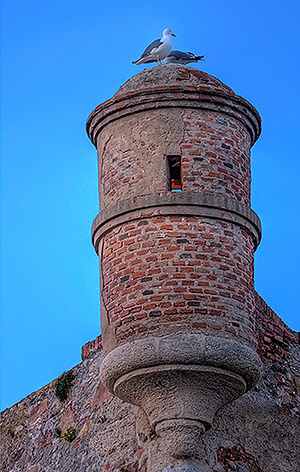 Nervy birds atop one of the Fortaleza's several garitas. Nervy birds atop one of the Fortaleza's several garitas. |
|
The Moors' only route of attack was from the west, as the only potential landing sites on Ceutaupon which a seaborne force might land were well defended, so they had to get past the Royal Wall. This decades-long siege was highlighted by intermittent fighting, however, and lulls in the action gave the Spanish plenty of opportunities to fortify their wall. A large relief force finally arrived from Spain in 1720, and the Moors were bloodily driven from the area.
|
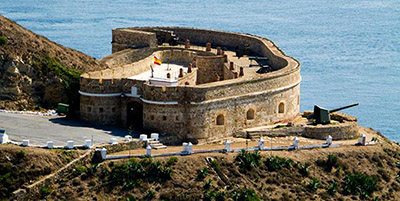 The Castillo del Desnarigado, built by the Spanish in the 1690's to protect a potential landing site on the south side of the peninsula. The Fuerte del Sarchal, little more than a protected gun battery, was also built to cover another site. |
 |
Throughout all of these momentous events, there was a fortification atop Monte Hacho. Originally built by either the Romans or Byzantines, this was obviously intended to serve as a stronghold, from whence much of the shipping through the Strait of Gibraltar could be observed. Some improvements had been made to this edifice by Ceuta's many masters through the centuries, but by the 18th century it was little more than a crumbling ruin.
Thankfully, the Spaniards finally got around to thinking in starfort terms by the middle 1700's.
|
|
|
Designed by an engineer by the name of Juan Caballero, the Fortaleza de Hacho integrated some of Monte Hacho's existing medieval fortification, which account for the towers that stud the fort's curtain walls. The new fort was intended to house some 200 soldiers, who must have had plenty of space in which to relax, because this starfort is huge! Note that it encloses two soccer fields, which may make it unique amongst starforts!
|
The Moors returned in 1790 to try their luck at the Royal Wall once again, but made no headway whatsoever against its state-of-the-art fortifications. In a way, the construction of the Castillo de Hache marks the end of Ceuta's military history: It and the Royal Wall were pretty darned impregnable by the end of the 18th century, and increasing industrialized European interest in the region dampened the Moorish desire for conquest.
The Castillo de Hacho was garrisoned by the British Army during the Napoleonic Wars (1803-1815), at least during the periods in which Spain and Great Britain were allied. In the mid-18th century Ceuta became Spain's Guantanamo Bay, as all of its worst criminals were sent to cool their heels at the Castillo de Hacho. The fort became a full-fledged prison in 1870. |
 |
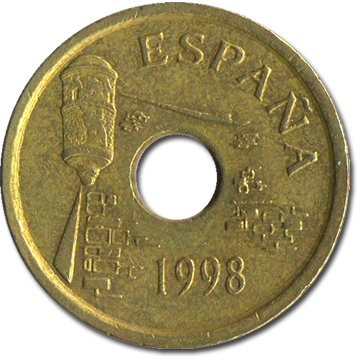 25 Pesetas, minted in honor of the fortifications of Ceuta. 25 Pesetas, minted in honor of the fortifications of Ceuta. |
|
Spain gained influence over much of coastal Morocco through the 19th century. When Spain finally granted independence to "Spanish Morocco" in 1956, it retained Ceuta as Spanish territory, which is, weirdly, what it remains today. The Castillo de Hache is still garrisoned by the Spanish military, and is closed to the public. It is possible to walk around the fort's walls, however. |
|
|
|
When Spain gained Ceuta thanks to their kooky Dynastic Union with Portugal in 1580, they found their new enclave protected by a moated, casemated wonder...and set about fortifying the walls even more impressively!
|
If you're like me, the first thing you thought when you saw this map to the right was, well, why wouldn't anyone interested in overwhelming this little spit of land just hop in a boat and sail around these walls? The answer to this perfectly reasonable query is that, there are very few decent places to land a boat on Ceuta. Much of the island has sheer rock walls shooting almost directly up from the surf, and the two small beaches that are available were easy to defend. At the same time, an attacking force would be unable to interfere with supplies and reinforcements shipped in from the motherland.
|
 |
|
|
Which is exactly what happened at the end of the 17th century! The Moors made a move to attack Ceuta in 1694, and initially came close to overwhelming the Royal Walls.
|
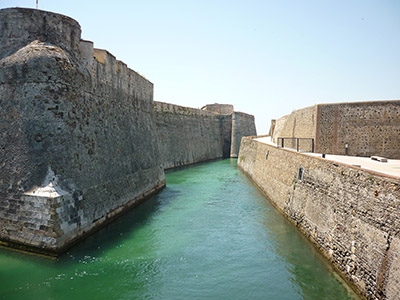 Betwixt the Royal Walls is a navigable moat. Go right ahead and paddle on through, kayakers! Betwixt the Royal Walls is a navigable moat. Go right ahead and paddle on through, kayakers! |
 |
The Siege of Ceuta went on for nearly 30 years, during which time the Spanish took advantage of every lull in the fighting to reinforce the Royal Walls and add a dizzying array of outerworks, through which the Moors were ultimately unable to fight their way through.
Demilunes, ravelins and hornworks were the state of the art in European fortification during this period, and they proved themselves yet again in this situation.
"Just wait until I invent the aeroplane, bellowed Moroccan leader Moulay Ismail Ibn Sharif, as he shook his fist in impotent rage towards the Royal Walls. (No, he didn't.) |
|
A Spanish relief force arrived at Ceuta in 1720 and sent the Moors packing, though the Moroccans returned once the overwhelming Spanish force departed. Moulay Ismail died in 1727, whereupon his army lost interest in the siege and left...only to return in 1732 to try again, but by this point Ceuta's defenses were so very impregnable that the Moors threw up their arms and left in 1734.
|
Today, Ceuta's Royal Walls are a bustling tourist attraction, with a series of shops and restaurants embedded therein. Almost all of the outerworks we see to the right are gone, having been razed to make room for urban development.
Though unquestionably part of Africa, Ceuta remains "an integral part of the Spanish state"...a claim with which Morocco reportedly has an issue, but another Moroccan siege of Ceuta seems unlikely at this time. |
 |
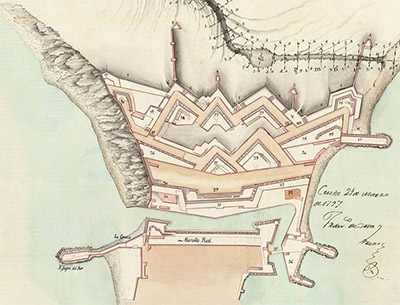 The Royal Wall's impressive outerworks. Let's see you get past that, Moors! The Royal Wall's impressive outerworks. Let's see you get past that, Moors! |
|
|
|
|
|
|
 |




